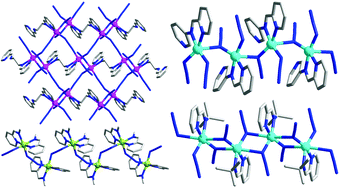Chelating Schiff base assisted azide-bridged Mn(ii), Ni(ii) and Cu(ii) magnetic coordination polymers†
Abstract
Four new Mn(II), Ni(II) and Cu(II) coordination

Maintenance work is planned for Wednesday 1st May 2024 from 9:00am to 11:00am (BST).
During this time, the performance of our website may be affected - searches may run slowly and some pages may be temporarily unavailable. If this happens, please try refreshing your web browser or try waiting two to three minutes before trying again.
We apologise for any inconvenience this might cause and thank you for your patience.
* Corresponding authors
a
Institute of Materials Research and Engineering, A*STAR (Agency for Science, Technology and Research), 3 Research Link, Singapore 117602, Singapore
E-mail:
bais@imre.a-star.edu.sg
Tel: +(65) 65141515
b
Beijing National Laboratory for Molecular Sciences, State Key Laboratory of Rare Earth Materials Chemistry and Applications & PKU-HKU Joint Laboratory in Rare Earth Materials and Bioinorganic Chemistry, College of Chemistry and Molecular Engineering, Peking University, Beijing 100871, China
E-mail:
yan@pku.edu.cn
c School of Chemical Biology and Pharmaceutics, Capital Medical University, Beijing 100069, China
d
Shanghai Key Laboratory of Green Chemistry and Chemical Processes, Department of Chemistry, East China Normal University, Shanghai 200062, China
E-mail:
eqgao@chem.ecnu.edu.cn
e Department of Chemistry, National University of Singapore, 3 Science Drive 3, Singapore 117543, Singapore
Four new Mn(II), Ni(II) and Cu(II) coordination

 Please wait while we load your content...
Something went wrong. Try again?
Please wait while we load your content...
Something went wrong. Try again?
S. Bai, C. Fang, Z. He, E. Gao, C. Yan and T. S. A. Hor, Dalton Trans., 2012, 41, 13379 DOI: 10.1039/C2DT31186K
To request permission to reproduce material from this article, please go to the Copyright Clearance Center request page.
If you are an author contributing to an RSC publication, you do not need to request permission provided correct acknowledgement is given.
If you are the author of this article, you do not need to request permission to reproduce figures and diagrams provided correct acknowledgement is given. If you want to reproduce the whole article in a third-party publication (excluding your thesis/dissertation for which permission is not required) please go to the Copyright Clearance Center request page.
Read more about how to correctly acknowledge RSC content.
 Fetching data from CrossRef.
Fetching data from CrossRef.
This may take some time to load.
Loading related content
